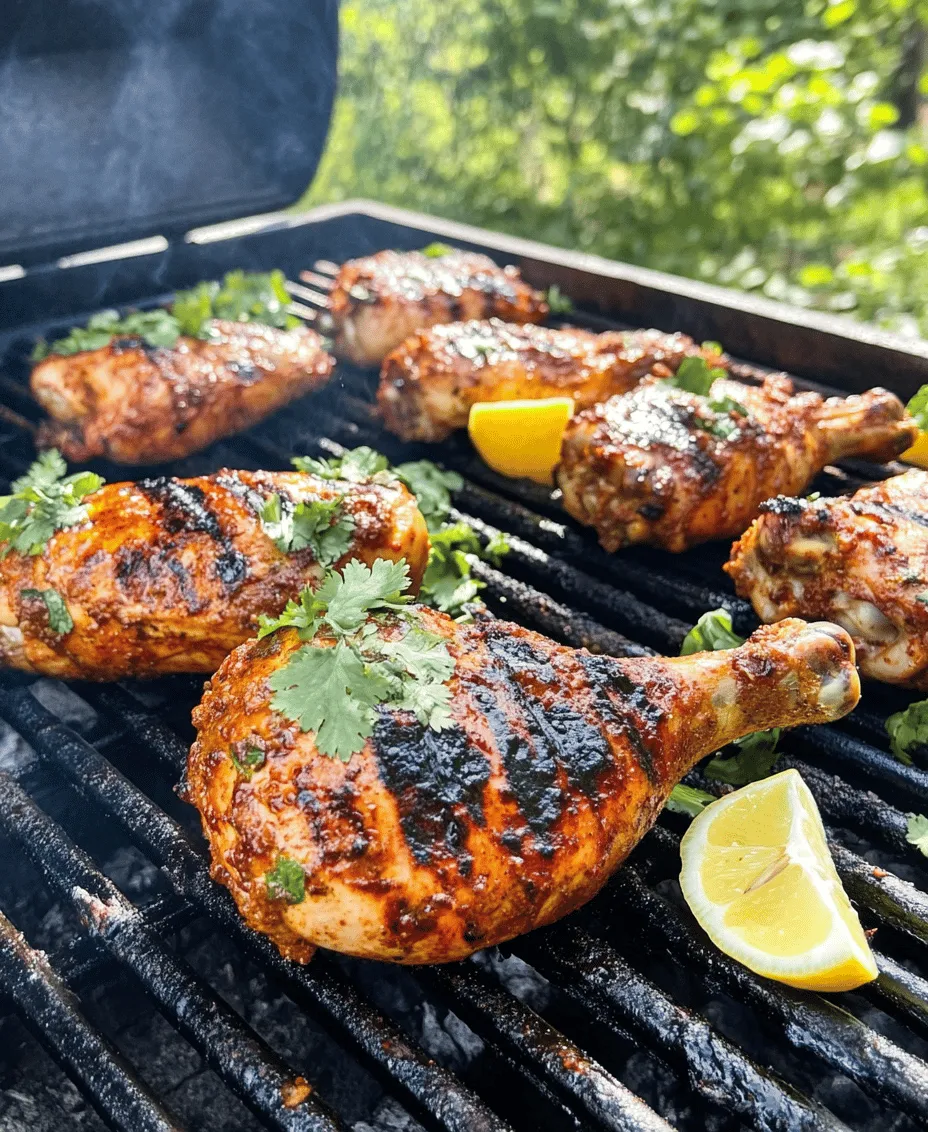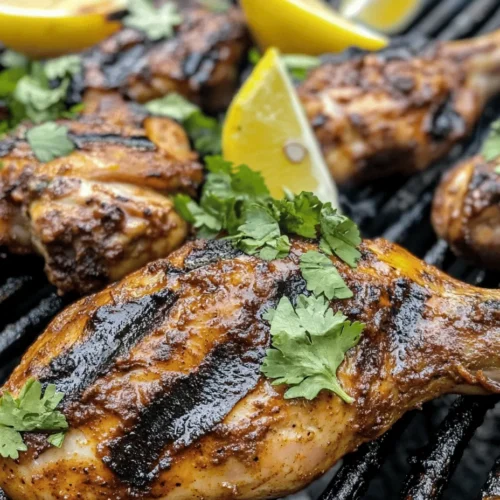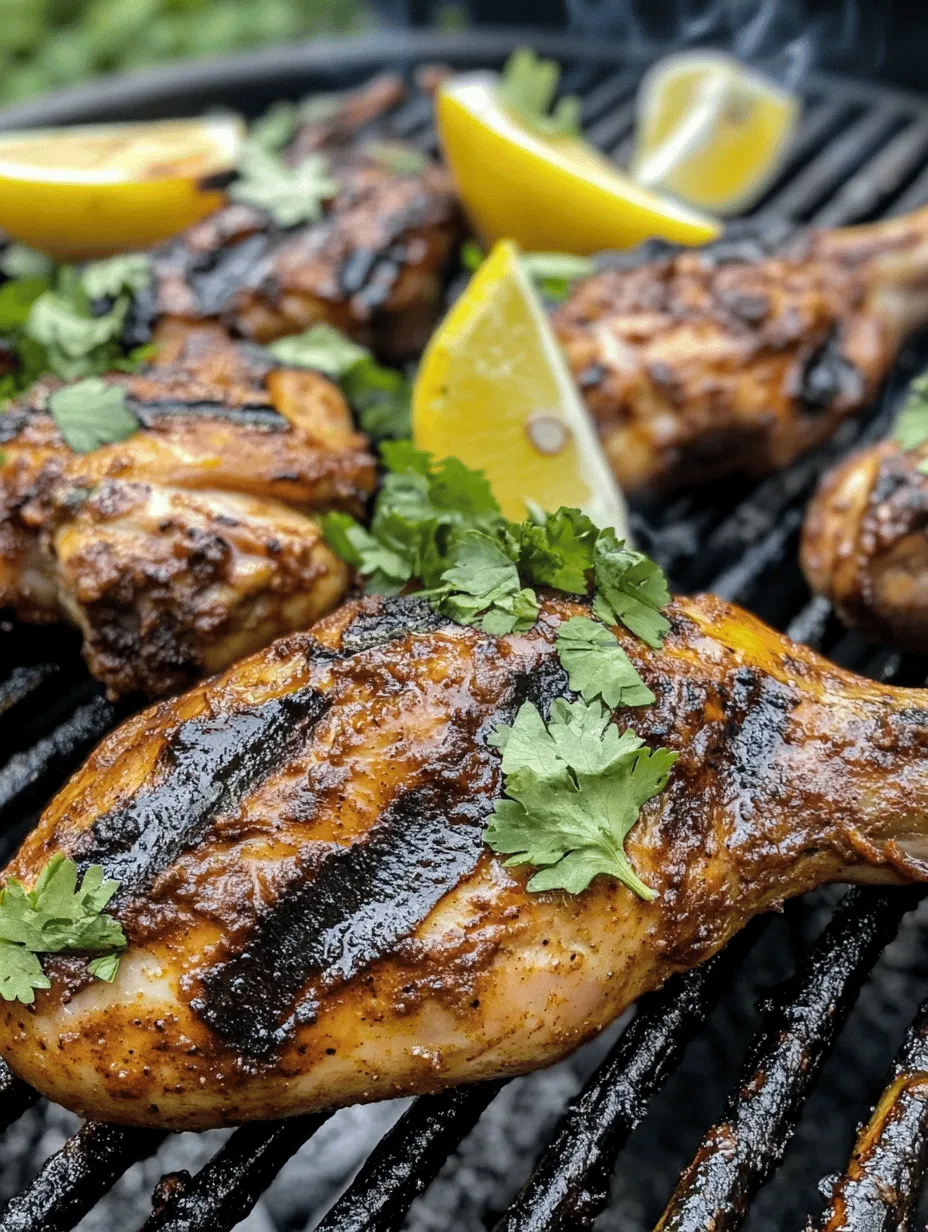Introduction to Tandoori Delight: Grilled Tandoori Chicken
Tandoori chicken is more than just a dish; it’s a culinary experience that transports you to the heart of Indian culture. Renowned for its vibrant flavors, smoky aroma, and tantalizing spices, this grilled tandoori chicken recipe is ideal for any occasion—be it a festive gathering or a cozy weeknight dinner. The magic of tandoori cooking lies in its unique blend of spices and the traditional method of cooking that imparts an irresistible flavor to the chicken. In this article, we will delve into the origins of tandoori cooking, the essence of its marinade, and the techniques you need to create perfectly grilled chicken that’s juicy on the inside and crispy on the outside. Get ready to impress your family and friends with this delightful dish!
Understanding Tandoori Cooking
Exploring the History of Tandoori Cuisine
Tandoori cooking has its roots deeply embedded in the rich culinary traditions of India. The term “tandoor” refers to a clay oven that has been used for centuries to cook various dishes, particularly in the northern regions of India. Its origins can be traced back to ancient times when nomadic tribes used these ovens to cook meat and bread over open flames. The tandoor became an intrinsic part of Indian cooking, offering a unique way to achieve high temperatures that create a distinct char and flavor in the food.
As the tandoor evolved, it became a staple in Indian households and restaurants. The traditional method of cooking in a tandoor involves marinating the chicken in a flavorful mixture of spices and yogurt, which tenderizes the meat and infuses it with rich flavors before it’s placed in the oven. The high heat of the tandoor not only cooks the chicken quickly but also seals in the juices, resulting in incredibly tender and succulent meat.
The Cultural Significance of Tandoori Flavors
Tandoori chicken is not just a popular dish; it holds cultural significance in Indian cuisine. It symbolizes the celebration of flavors, communal dining, and the joy of sharing food with loved ones. In many Indian households, especially during festivals and special occasions, tandoori chicken takes center stage at the dining table. The dish represents the perfect balance of spices, showcasing the culinary artistry that Indian cuisine is known for.
In addition to its cultural importance, tandoori cooking has gained immense popularity worldwide, thanks to its distinctive taste and the growing interest in Indian food. You can find tandoori chicken on menus in restaurants across the globe, often adapted to local tastes while preserving the essence of traditional flavors.
How the Tandoor Works: Traditional vs. Modern Grilling Techniques
The tandoor oven operates on a unique principle of cooking that combines direct and indirect heat. The clay walls of the tandoor retain heat, cooking the food evenly and imparting a smoky flavor that is hard to replicate with conventional cooking methods. Traditional tandoor cooking involves skewering marinated meat and placing it vertically inside the oven, allowing it to cook to perfection.
In modern kitchens, while we may not have access to a traditional tandoor, we can still achieve similar results using grilling techniques. Whether you’re using a gas grill, charcoal grill, or even an oven, the key is to replicate the high heat that characterizes tandoor cooking. This can be accomplished by preheating your grill to a high temperature and using indirect heat to ensure that the chicken cooks through without drying out.
Ingredients for Tandoori Chicken
An Overview of Key Ingredients
To make authentic tandoori chicken, you’ll need a handful of key ingredients that come together to create a flavor profile that is both complex and satisfying. Here’s a breakdown of what you’ll need:
– Chicken: The star of the dish, bone-in chicken pieces (legs, thighs, and wings) are typically preferred for their flavor and juiciness.
– Yogurt: A crucial ingredient in the marinade, yogurt helps tenderize the chicken and adds a creamy texture.
– Tandoori Masala: A blend of spices that gives tandoori chicken its characteristic flavor. It usually includes cumin, coriander, turmeric, paprika, and garam masala.
– Garlic and Ginger: Fresh garlic and ginger add depth to the marinade, enhancing the overall flavor.
– Lemon Juice: Adds acidity to the marinade, balancing the richness of the yogurt.
– Fresh Herbs: Cilantro and mint can be added for a fresh finish and additional flavor.
The Role of Yogurt in Marination
Yogurt is the backbone of the tandoori marinade and serves multiple purposes. Its acidity helps break down the proteins in the chicken, resulting in a tender texture. Additionally, yogurt acts as a carrier for the spices, ensuring that each bite is infused with flavor. When marinated, the chicken absorbs the yogurt and spices, creating a juicy and flavorful dish.
For best results, use full-fat yogurt, as it provides a creamier texture and richer flavor compared to low-fat options. If you’re looking for a dairy-free alternative, coconut yogurt can also work well, though it may impart a different flavor.
Understanding the Spice Blend: Tandoori Masala and Beyond
Tandoori masala is a quintessential spice blend that elevates the flavor of tandoori chicken. While you can find pre-packaged tandoori masala in stores, making your own blend allows you to customize the flavors to your liking. The essential spices include:
– Cumin: Adds a warm, earthy flavor.
– Coriander: Offers a citrusy note.
– Turmeric: Provides a vibrant color and subtle earthiness.
– Paprika: Contributes sweetness and color.
– Garam Masala: A blend of fragrant spices that adds complexity.
Feel free to experiment with additional spices such as cayenne pepper for heat, or fenugreek for an aromatic touch. The beauty of tandoori cooking lies in its adaptability, allowing you to create a marinade that suits your taste preferences.
The Importance of Fresh Ingredients: Garlic, Ginger, and Herbs
Fresh ingredients are crucial in tandoori chicken, as they significantly enhance the dish’s flavor. Using fresh garlic and ginger instead of powdered forms will provide a sharper, more vibrant taste. The aromatic qualities of these ingredients are essential for creating a well-rounded marinade that penetrates the chicken.
Similarly, adding fresh herbs like cilantro or mint not only brightens the dish but also adds a refreshing element that complements the spices. When preparing your tandoori chicken, prioritize freshness to ensure that every bite bursts with flavor.
Preparation Steps for Grilled Tandoori Chicken
Creating the Marinade: A Step-by-Step Guide
Now that we have a solid understanding of the ingredients, let’s dive into the preparation. Making the marinade is the first and most crucial step in achieving delicious tandoori chicken. Follow these steps to create a perfect marinade:
1. Gather Your Ingredients: Start by collecting all the ingredients needed for the marinade—yogurt, spices, garlic, ginger, lemon juice, and salt.
2. Mix the Marinade: In a mixing bowl, combine the yogurt, tandoori masala, minced garlic, grated ginger, lemon juice, and salt. Mix well until all the ingredients are fully incorporated. The consistency should be thick and creamy.
3. Prepare the Chicken: Take your chicken pieces and score them lightly with a sharp knife. This will allow the marinade to penetrate deeper into the meat, ensuring maximum flavor.
4. Marinate the Chicken: Place the chicken in a large bowl or a resealable plastic bag. Pour the marinade over the chicken, ensuring each piece is thoroughly coated. Seal the bag or cover the bowl with plastic wrap.
5. Marination Time: For the best results, allow the chicken to marinate for at least 4 hours, or ideally overnight. The longer the chicken sits in the marinade, the more flavorful and tender it will become.
The Science of Marination: Why Timing Matters
Marination is a crucial process that not only enhances flavor but also significantly impacts the texture of the chicken. As the chicken marinates, several chemical reactions occur:
– Flavor Infusion: The spices and yogurt penetrate the meat, allowing the flavors to meld together. This results in a harmonious taste that is both rich and complex.
– Tenderization: The acidity in the yogurt breaks down the proteins in the chicken, making it more tender. This is why marinating for a shorter time (less than an hour) may not yield the same results as a longer marination period.
– Moisture Retention: Properly marinated chicken retains moisture during cooking, preventing it from drying out. This is especially important when grilling, as high heat can quickly lead to dry meat.
By understanding the science behind marination, you can optimize the process and ensure that your grilled tandoori chicken is nothing short of spectacular.
In the following sections, we will explore the grilling techniques, cooking times, and serving suggestions that will take your tandoori chicken to the next level. Stay tuned as we continue to uncover the secrets to creating the ultimate tandoori delight!

Preparing the Chicken: Techniques for Optimal Flavor Absorption
To achieve the authentic taste of tandoori chicken, the way you prepare and marinate the chicken is crucial. The longer the chicken marinates, the more the spices will penetrate the meat, resulting in a burst of flavors with every bite. Here are some techniques to ensure optimal flavor absorption:
1. Choose the Right Cut: Opt for bone-in chicken pieces, such as thighs and drumsticks, as they tend to remain juicier during grilling. Bone-in cuts also absorb the marinade better than boneless pieces.
2. Marination Time: Allow the chicken to marinate for at least 4 hours, but for the best results, leave it overnight in the refrigerator. This extended time allows the spices to fully infuse into the meat.
3. Scoring the Chicken: To enhance flavor absorption, gently score the chicken pieces with shallow cuts on the surface. This technique creates more surface area for the marinade to penetrate, ensuring that each bite is packed with flavor.
4. Use of Yogurt: The base of tandoori marinade is yogurt, which not only adds creaminess but also helps tenderize the chicken. The acidity in yogurt breaks down the proteins, resulting in a more tender texture.
Grilling Techniques for Perfect Tandoori Chicken
Grilling is an art, and mastering the right techniques can elevate your tandoori chicken to restaurant-quality perfection. Here’s how to achieve that ideal char and flavor.
Prepping the Grill: Tips for Setting the Ideal Temperature
1. Preheat the Grill: Whether using a gas or charcoal grill, preheat your grill to high heat (about 450°F to 500°F). This high temperature is essential for achieving that signature charred exterior.
2. Oil the Grates: Prevent the chicken from sticking by oiling the grill grates. Using a paper towel dipped in cooking oil, wipe the grates before placing the chicken on them.
3. Create Two Heat Zones: If using a charcoal grill, arrange the coals on one side to create a hot zone and leave the other side cooler. This setup allows you to sear the chicken over high heat and move it to the cooler side to finish cooking without burning.
Grill Setup: Charcoal vs. Gas Grilling Methods
– Charcoal Grilling: If you’re using a charcoal grill, use hardwood charcoal for a smokier flavor. Once the coals are ashed over, place the chicken pieces directly over the heat for a few minutes to sear, then transfer to the cooler side of the grill to cook through.
– Gas Grilling: For gas grilling, set one side to high heat and the other to medium. Sear the chicken on the high-heat side, then move it to the medium-heat side, closing the lid to retain heat and moisture.
Monitoring Cooking Time: Ensuring Perfectly Cooked Chicken
Cooking times may vary based on the size of the chicken pieces and the type of grill used. Here are some guidelines:
1. Cooking Time: Grill chicken for about 15-20 minutes, turning occasionally. Use a meat thermometer to check the internal temperature—chicken should reach 165°F to be fully cooked.
2. Visual Cues: Look for the chicken to turn a vibrant orange-red color, and ensure the juices run clear when pierced. Avoid overcooking, as this can dry out the meat.
3. Let It Rest: Once off the grill, let the chicken rest for 5-10 minutes. This allows the juices to redistribute, resulting in a juicier final product.
Serving Suggestions and Pairings
Now that your tandoori chicken is perfectly grilled, it’s time to serve it! Here are some ideas for side dishes, garnishing, and beverages that will enhance your dining experience.
Ideal Side Dishes to Complement Tandoori Chicken
Tandoori chicken pairs beautifully with various sides that can balance its bold flavors:
– Naan Bread: Soft, warm naan is perfect for scooping up chicken and dipping into sauces.
– Basmati Rice: Fluffy basmati rice, either plain or flavored with saffron and spices, is an excellent base for your chicken.
– Cucumber Raita: This yogurt-based side dish provides a cooling effect against the spices in the chicken. Simply mix diced cucumbers, yogurt, mint, and spices for a refreshing accompaniment.
– Salad: A simple salad with mixed greens, tomatoes, and a tangy dressing can add a fresh contrast to the rich flavors of the chicken.
How to Present Your Dish: Garnishing with Fresh Cilantro and Lemon
Presentation is key in elevating your meal. Here’s how to beautifully present your tandoori chicken:
1. Garnish: After grilling, sprinkle chopped fresh cilantro over the chicken for a pop of color and freshness. You can also add thinly sliced red onions for added crunch and flavor.
2. Lemon Wedges: Serve lemon wedges on the side. A squeeze of fresh lemon juice over the chicken just before eating enhances the flavors and adds a zesty brightness.
3. Plating: Arrange the chicken pieces on a large platter, surrounded by your accompanying sides. This communal style of serving encourages sharing and conversation around the meal.
Beverage Pairings: What to Serve with Tandoori Chicken
Choosing the right beverages can enhance your dining experience. Consider these options:
– Lassi: A traditional Indian yogurt drink, lassi can be sweet or salty. A mango lassi complements the spices beautifully.
– Chai: A cup of spiced chai tea can be a comforting pairing, especially if you’re serving tandoori chicken as part of a larger meal.
– Beer: Light lagers or wheat beers can balance the spices in tandoori chicken, making for a refreshing accompaniment.
– Wine: If you prefer wine, a chilled Sauvignon Blanc or a light-bodied red like Pinot Noir can work well.
Conclusion: Savoring Your Tandoori Delight
Making grilled tandoori chicken is not just about cooking; it’s about creating an experience filled with flavor and tradition. As you take your first bite, you’ll appreciate the tender, flavorful chicken that has been marinated to perfection and grilled to a delightful char. The joy of sharing this dish with friends and family brings people together, inviting everyone to enjoy the rich heritage of Indian cuisine.
As you explore the world of Indian cooking, let this tandoori chicken be just the beginning. From fragrant biryanis to rich curries, there is a wide array of dishes to discover and savor. So gather your loved ones, fire up the grill, and dive into the delightful flavors of tandoori chicken. With each meal, you’ll not only enjoy delicious food but also the warmth of shared experiences and the excitement of culinary exploration.



